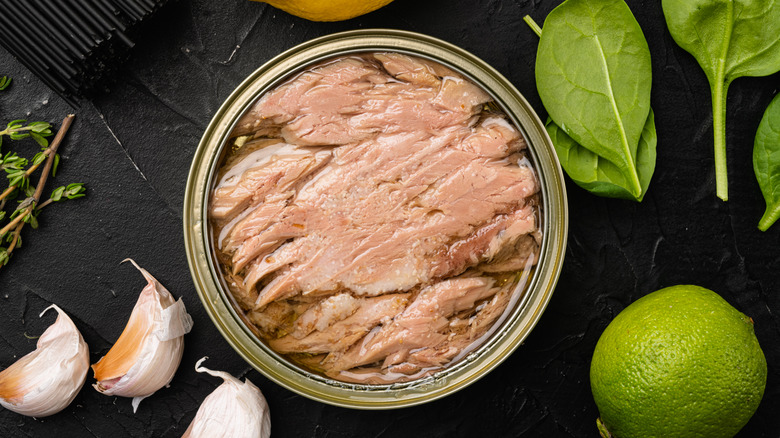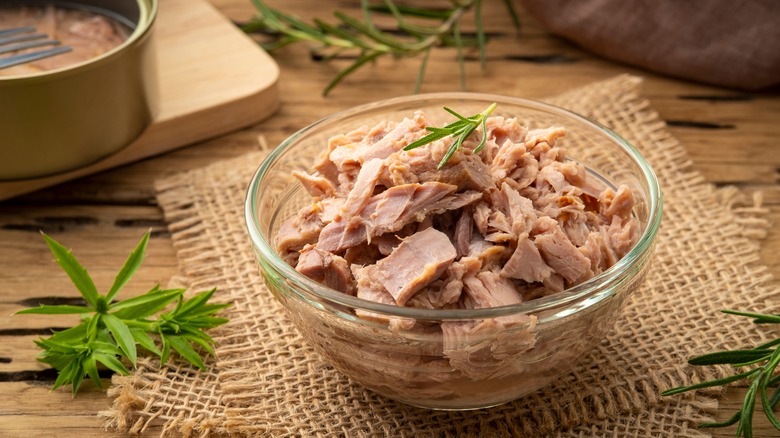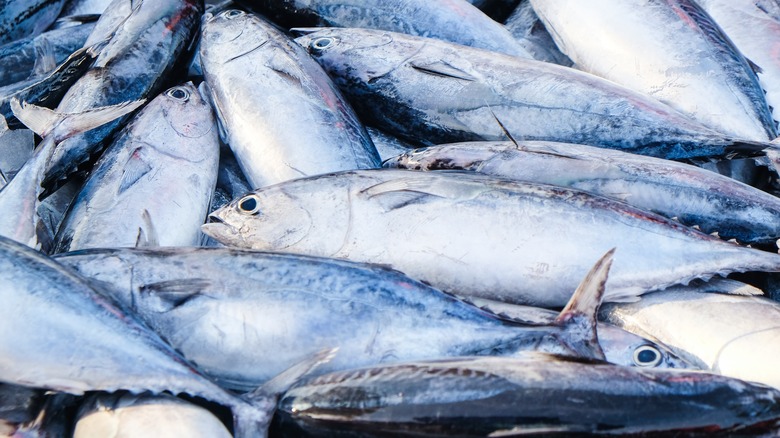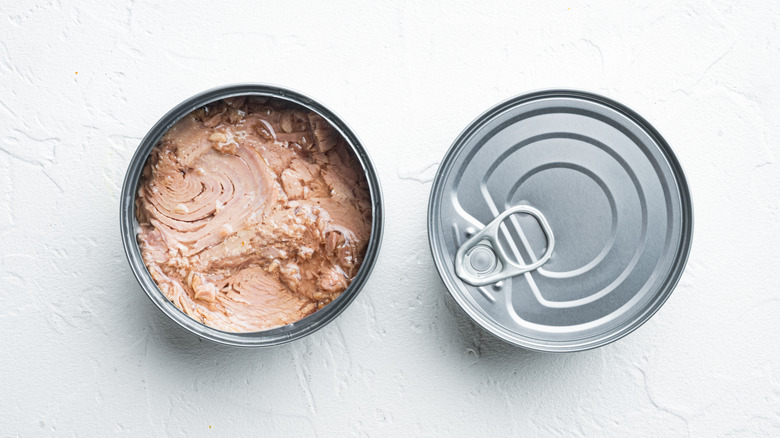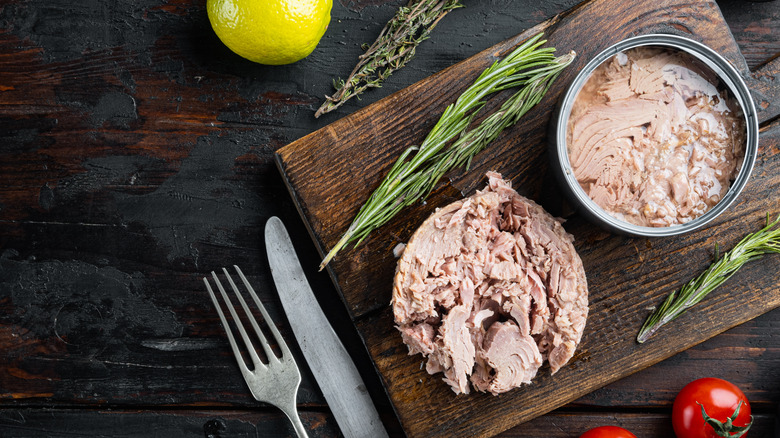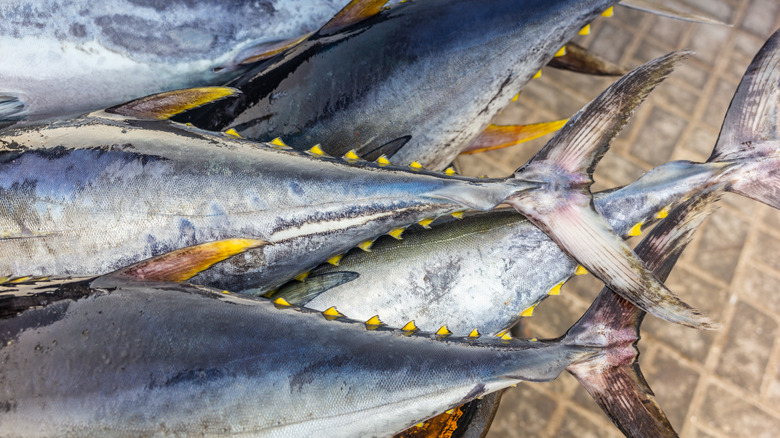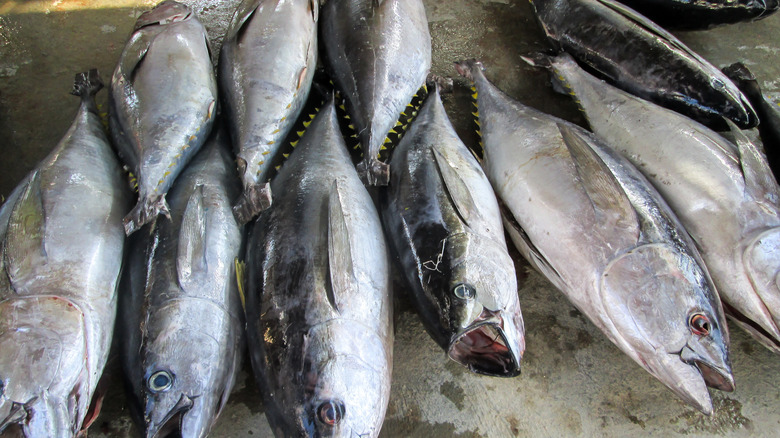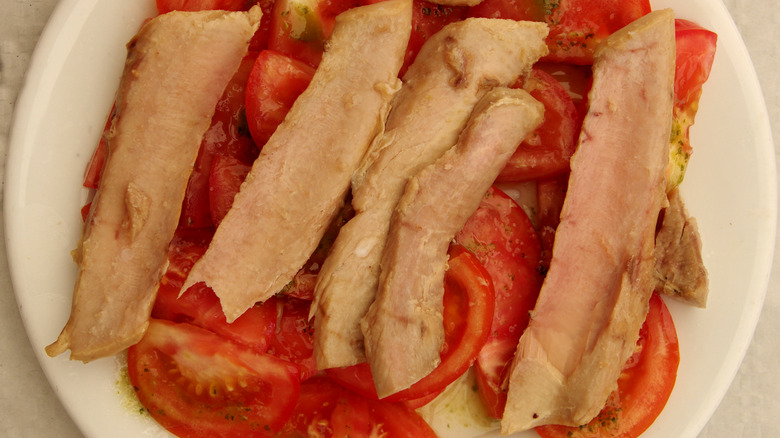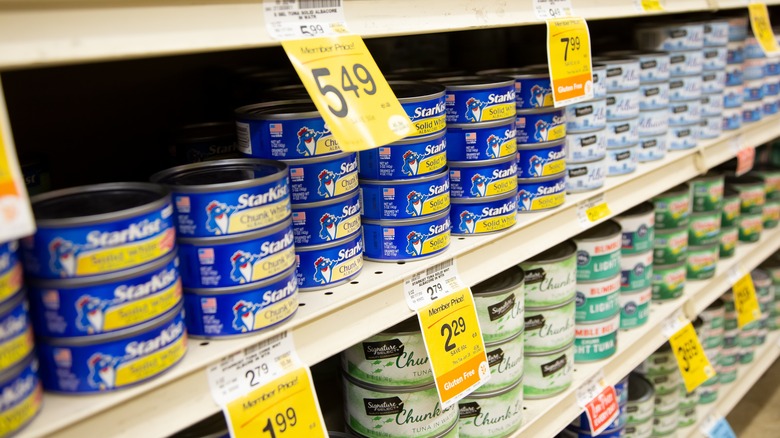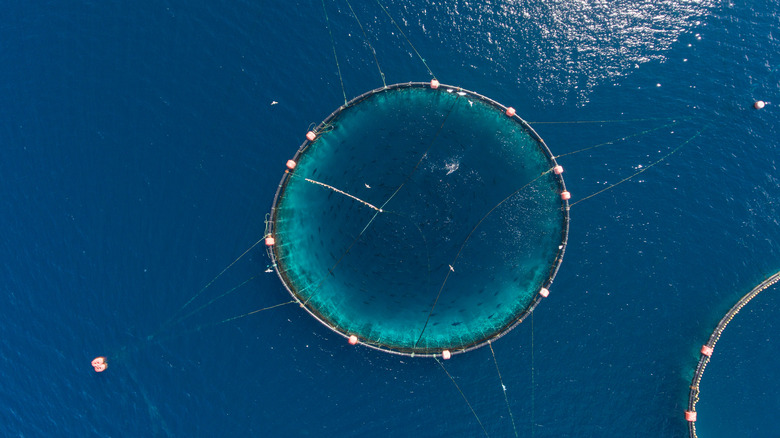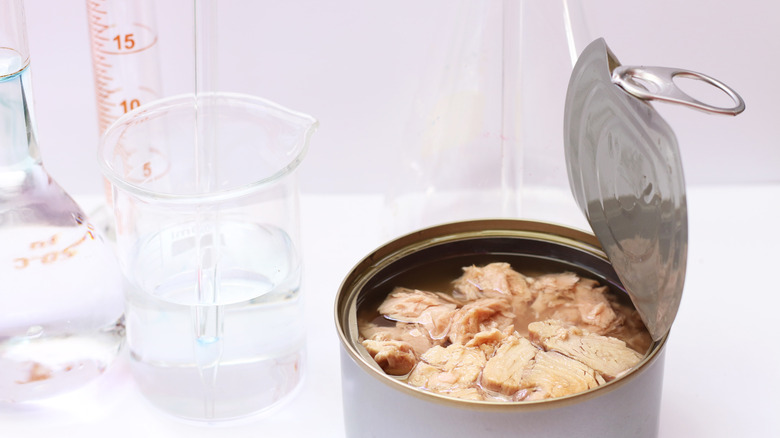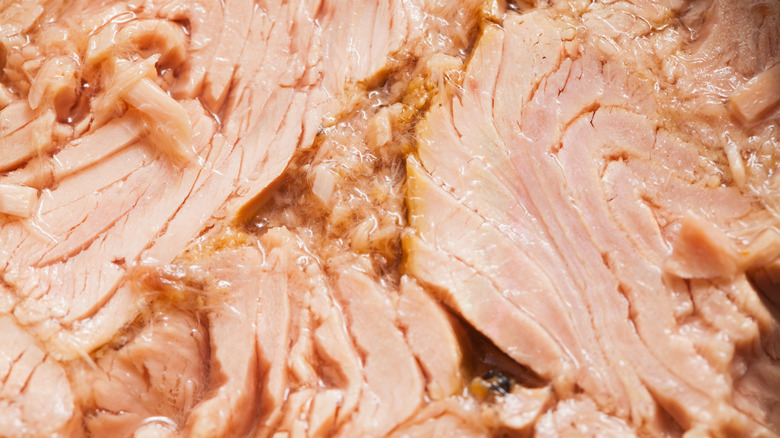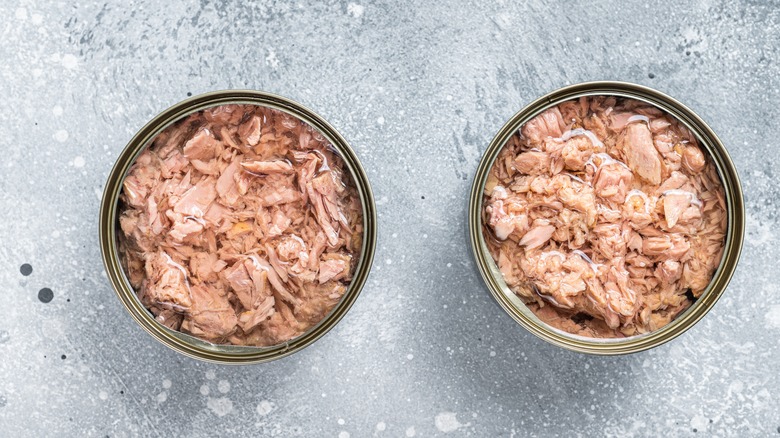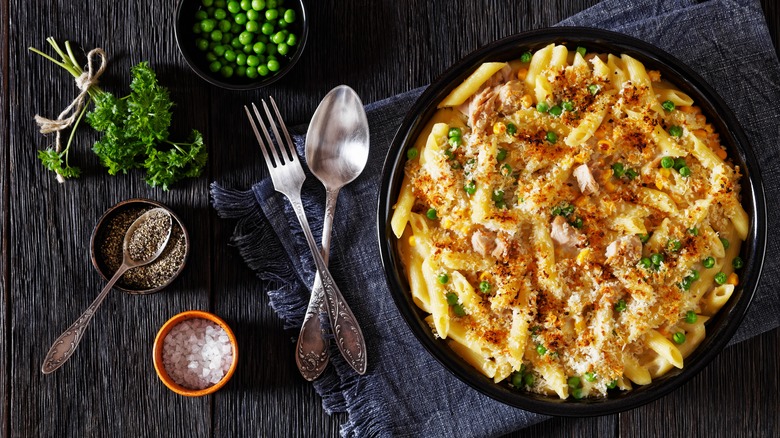A Beginner's Guide To Canned Tuna Varieties
Tuna is one of those foods that pretty much everyone loves. If you regularly include fish in your diet, there's a fair chance that you have a can or two stashed away in your pantry. And even folks who aren't fans of seafood can't resist the charms of the "chicken of the sea." Tuna's popularity is due in part to its ready-to-eat nature, with canned tuna making a quick and easy base for a host of meals. And this popularity is only set to grow, with the $9 billion canned tuna market set to skyrocket and be worth approximately $13.36 billion by 2031, per GlobeNewswire.
But like all animals, tuna comes in a few different shapes and sizes. And those shapes and sizes can all make their way into those cans you're picking up from the market. Canned tuna can come from several different tuna types, and those different types all have distinct flavors, colors, textures, and uses that they're best suited for. We wanted to open the lid (no pun intended) on canned tuna varieties, so you can figure out which one is best for you. Let's dive in.
You can tell tuna apart by its color and texture
If you've ever opened a can of tuna and have been surprised by a different color to the meat you're normally used to, never fear, your product isn't off. It's likely that you've just picked up a new type of tuna. There are a few main tuna varieties and can be generally separated into "white tuna" and tuna that has darker meat. The meat's tone will indicate which tuna it's come from. For example, light-colored meat will often come from albacore, a white tuna. Meanwhile, darker meat will usually come from either bigeye, skipjack, or yellowfin tuna.
White tuna will also generally have a more robust, firm texture, even if it's been separated into smaller chunks. On the other hand, darker meat tends to be a little more flaky and tender. The firmness of your tuna is useful to know before opening and using it, because more solid pieces of albacore may be better suited in situations where you need your tuna to really stand out and be a presence. Gentler, darker tuna might be better for mixing into other dishes, where it's not so essential to have large pieces. Remember, too, that the darker the meat is, the more likely it is to have a bold, potentially "fishier" flavor.
Skipjack tuna is the most popular in the U.S.
Got a can of tuna in your house? It's likely skipjack. Skipjack tuna is by far the most used type of canned fish in the United States, with seven out of all cans containing it (per About Seafood). This versatile tuna has a slightly darker, pinkish color, and tends to turn into flakes easily, thanks to its softer meat. As a result, it tends to be best employed in dishes that have other textural elements, like a tuna salad full of crunchy vegetables. The tenderness of the meat doesn't mean that it compromises on flavor, though. This is one of the stronger-tasting tuna varieties out there, with a meaty flavor.
Part of why skipjack tuna is so popular is not just its taste, but its availability. Unlike other tuna, skipjack can be fished sustainably, and their population remains healthy thanks to their fast reproductive cycle. Skipjack is also one of the best choices that consumers who have concerns about mercury levels can make. They generally have one of the lowest levels of mercury of all of the tuna types out there, with albacore, yellowfin, and bigeye all containing higher mercury concentrations.
Albacore has a mild flavor
As fish go, tuna is probably one of the most versatile. But that versatility depends largely on what type of tuna you buy, and the strength of its flavor. That's why, if you're looking not to overpower your dish with a fishy taste, you should go for albacore. Albacore tuna has one of the mildest flavors of the widely available tuna varieties, and a light, almost-white flesh. This unassuming taste makes it a safer choice for people who aren't into fishy, briny flavor notes.
Albacore can come both oil-packed and packed in water and may be flaked into smaller pieces or canned in large chunks. Whichever form of albacore you go for, though, it's useful to be aware of your choice's impact. Overfishing of albacore has led to the tuna becoming "near-threatened," which raises concerns about the future of this fish. If you're buying albacore tuna, try to look for brands that have been sustainably sourced. And, if you're especially concerned about the impact of buying it, try to opt for a less-threatened tuna, like skipjack.
Tongol tuna is pretty versatile
Skipjack, yellowfin, and albacore. Most people have heard of these tuna types. But what about tongol? While potentially not as well-known as the main types of tuna, tongol is a worthwhile choice in its own right. These light tuna fish are smaller than other varieties and are often fished around Southeast Asia. Like albacore, tongol tuna has a light, mild-tasting flesh, and breaks down into flakes especially well. Thanks to its texture and its taste, it's superb for use in everything from tuna salads to pasta dishes.
Tongol, which may also be found under the name longtail or northern bluefin, also has the advantage of being slightly cheaper than other tuna types. This is, arguably, thanks to it not having as immediate name recognition as other fish. But that doesn't take away from its nutritional value, as like all tuna, tongol is rich in protein and low in fat. And if you're trying to keep an eye on your mercury levels, you'll be pleased to hear that tongol has a lower concentration than alternative tuna choices.
Yellowfin tuna can have a fishier taste
You might not know it from the size of that can, but yellowfin tuna can get pretty big. This large tuna species, found in warm waters across the world, can reach up to 400 pounds in weight. Although yellowfin tends to be used for sushi, it can also be found in canned form. Importantly, though, it has a notably fishier taste than some other types of tuna, like albacore, and so is best employed as one of the main flavors in a meal.
However, there are two main things to consider when it comes to buying yellowfin tuna: Its mercury levels and its sustainability. Yellowfin's mercury content is notably higher than other tunas like skipjack, and eating it in large amounts could result in negative consequences to your mental health and motor skills, per Healthline. Yellowfin stocks in the Pacific and Indian oceans are also under increased pressure from aggressive fishing and are a threatened population in these parts of the world. For these reasons, it's advisable to limit your intake of this tuna, and if you're buying it in canned form, to choose an option that's both less mercury-heavy and less endangered.
Bigeye tuna may be known by a different name
If you've ever spotted the term "ahi tuna" on the side of a can, it might be bigeye. Both yellowfin and bigeye tuna are known by the term, which literally means "fire" and has its roots in traditional Hawaiian fishing practices. When prepared for culinary use, though, there's nothing fiery about this fish. Bigeye generally has a pretty mild flavor, and, as such, tends to be fairly versatile, often served as a steak or as sushi, as well as being canned.
Bigeye tuna tends to be leaner than some other types, having both low and saturated fat content. It's also particularly rich in minerals and vitamins like B6 and B12. This tuna's flesh is especially good for pairing with robust flavors, but it's also very at home as the main presence in a meal. One thing to bear in mind, though, is that bigeye has almost double the mercury concentration than albacore or yellowfin. This makes it the most mercury-rich of all tuna types, and, as a result, it should be eaten very sparingly.
Ventresca tuna is luxurious
For a lot of people, a regular can of tuna with a few additions is the perfect meal. But we all like to make things a little special now and again, right? And when those indulgent moments come along, a can of Ventresca tuna is all you need. Ventresca (which means "belly" in Italian) is a sumptuous cut of tuna that is commonly taken from the yellowfin or albacore varieties. This part of the fish is especially rich in oils and has a tender texture and an elegant taste.
Given how rich Ventresca is, especially as it often comes packed in olive oil, it tends to be best enjoyed with simple accompaniments. Don't be tempted to chop it up and put it in a tuna salad with some cheap mayo — it's a cut that deserved to be savored. Try serving it on a plain cracker alongside some fresh tomatoes and briny olives, or place it on a board with your favorite cheese and fruit. As you might expect, this canned tuna is significantly more pricey than your usual chosen brand for your work lunches. We're willing to bet you won't be disappointed, though.
There's no big difference between solid or chunk tuna
When choosing tuna, there's a lot more that goes into it than just picking up a tin and hoping for the best. Different types of tuna bring different flavors and appearances to the table — and different textures, too. But is there a reason that some tuna is sold in chunks, and some is solid?
In short, not really. Most types of tuna can be served in larger pieces, and processed down into slightly smaller chunks or flakes, and there's no massively discernible difference in taste. It all comes down to the fish size. Some types of tuna (like albacore) are much larger, and this makes their larger fillet easier to work with and trim down to can size. Other types of tuna, like skipjack, are smaller, so it can be harder to get big enough single pieces for cans – hence the smaller flakes.
To know what's inside, the best thing to do is to look at how it's labeled. If your can has "solid" on it, the pieces inside are likely larger, and more steak-like in consistency. If the can is labeled as being "chunk" tuna ... Well, you guessed it, it's likely been broken down into smaller, ready-to-eat pieces.
Canned tuna's price may not reflect its sustainability
It's a commonly-held belief that a higher price equates to a quality product. And quality all starts with where something comes from. As such, it's easy to assume that if one can of tuna is pricier than the other, it means that the more expensive one holds better-tasting, better-caught fish, that have been sourced sustainably.
Unfortunately, this may be untrue. The price of canned tuna may not have any relationship at all to how it's been fished, and a higher price may instead just be crafty marketing, to make you think it's better for the environment. To avoid being tricked by this, get wise to certain terms to ensure your tuna is sustainably sourced. Labels that have "FAD-free" or "pole and line" on them indicate that the fish inside has been caught with best practice, and not farmed or collected en masse. If your tuna doesn't have any of this, your best bet is to go by the type of tuna in the can. Yellowfin and bigeye tuna are usually more susceptible to the huge devices that collect fish in the oceans, due to their smaller size. Skipjack and albacore tuna, on the other hand, tend to be bigger and less likely to be trawled up before they reach their full maturity.
Mercury levels will vary depending on tuna type
One of the biggest concerns when it comes to tuna, and really any fish, is how much mercury they contain. And it's a fair thing to be worried about. Mercury works its way into fish from their surroundings and diet, and this then ends up in our food. That mercury can subsequently cause knock-on health effects, and over consuming it can be particularly dangerous for kids and pregnant people.
Tuna tends to be richer in mercury than other fish, so limiting it is necessary. But exactly how much mercury is in tuna depends on the variety you're eating. Skipjack tuna and "light" tuna tend to be lowest in mercury, and therefore safest to eat. Albacore, on the other hand, is usually more abundant in mercury. Bigeye and yellowfin tuna have especially high mercury concentrations. Whichever type you're eating, though, you should try not to overdo it — and if you're pregnant, or attempting to conceive, you should keep your canned tuna intake to a maximum of four per week. If you're enjoying your tuna in steak form, you should have even less — only two weekly.
What your tuna is packaged in may affect its nutrition
Once tuna is canned, it's important to keep it moist until it makes its way to your table. And the best way to do that? Well, submerge it in a liquid, of course! Tuna is routinely canned in water and oil, and both methods ensure that the fish stays flavorful during its time in its metal container.
However, whether your tuna comes in oil or water changes its nutritional profile considerably. Oil-packed tuna will, as you might expect, boost its calorie and fat content. If your tuna is packed in water, on the other hand, it will generally be lower in fat. One thing to consider is that if it's tuna canned in brine or salted water, then the sodium content of the overall meal will naturally be higher.
Water-packed tuna should usually be drained before you use it so that it doesn't end up making your plate soggy. If you buy tuna canned in oil, though, it's best to keep as much of that as possible. The oil used is usually of the heart-healthy kind, and rich in essential vitamins and minerals.
All types of canned tuna can go bad
We've all seen those films where someone ends up in a nuclear bunker. And what do they eat when they're down there? Canned foods, right? There is, of course, some truth to the image of endless canned products lining underground walls. Canning is an excellent way to preserve food like tuna, and when done properly, can extend the lifespan of your food significantly.
However, just because tuna's canned, doesn't mean it's good forever. Like all foods, canned tuna can deteriorate and go bad over time. The first thing you need to look at is its expiration date. If it's too far beyond that, you might want to throw it out. You should also dispose of your tuna if there's any damage to the can, like if it's bulging, dented, or leaking. Once you open the can, you should be on your guard for any strange smells or visible spoilage, or any deep discoloration of the fish. If you're still unsure whether you can eat the fish, you can do a last-resort taste test. But, in our opinion, you should just buy another can if there's any doubt about its freshness.
Dishes that work best with canned tuna
Canned tuna is a pantry staple for a reason: Not only is it long-lasting and tasty, but it's also almost mind-bogglingly versatile. This is a fish that can go into a variety of dishes and remains delicious every time. The best place to start with canned tuna is, of course, a traditional tuna salad. Mix canned tuna with mayonnaise, mustard, celery, onion, and seasonings, and then spoon it into a sandwich or on crackers. Tuna salad can be made with all types of canned tuna, but is probably best when made with smaller flakes or more tender meat, like with skipjack tuna. If you're feeling in the mood for a healthier version of the classic lunch staple, then there's also an option for you.
For a more complete meal, try a no-bake tuna noodle casserole, made with tuna, pasta, milk, cheese, and peas. Oil-packed tuna is a great choice to throw on top of a salad, with the additional oil acting as a dressing and flavoring for your leaves and vegetables. And if you're feeling really fancy, one of the best ways to use canned tuna is by making them into croquettes. All you need is tuna, eggs or breadcrumbs, some seasonings, and some oil. Place them on a plate, add some dipping sauce, and you're in heaven.
